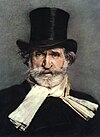I due Foscari
I due Foscari (De båda Foscari) är en opera (tragedia lirica) i tre akter med musik av Giuseppe Verdi och libretto av Francesco Maria Piave efter lord Byrons skådespel The Two Foscari (1821).
Historia
Vid 30 års ålder hade Verdi placerat sig som Vincenzo Bellinis och Gaetano Donizettis arvtagare i den italienska operavärlden. De ledande italienska operascenerna tävlade om att uppföra hans operor, och när Teatro Argentino i Rom beställde en till höstsäsongen 1844 tog han åter upp tanken att skriva en opera byggd på Byrons pjäs The Two Foscari, som Verdi redan hade diskuterat med librettisten Piave. Verdi deltog själv i utformningen av librettot, och mindre än fyra månader efter beställningen kunde han dirigera premiären den 3 november 1844. Operan mottogs dock inte lika entusiastiskt som sina föregångare. Den uppfördes dock ofta i över 30 år, varpå den föll i glömska.
Personer
- Francesco Foscari, Venedigs doge (baryton)
- Jacopo Foscari, hans son (tenor)
- Lucrezia Contarini, Jacopos hustru (sopran)
- Jacopo Loredano, medlem av De tios råd (bas)
- Barbarigo, senator (tenor)
- Pisana, Lucrezias väninna och förtrogna (sopran)
- De tios råds tjänare (tenor)
- Dogens tjänare (bas)
- Medlemmar av De tios råd och senaten, Lucrezias tjänarinnor, venetianska damer, folk, maskeraddeltagare (kör)
Handling
Venedig 1547
Akt I
Jacopo Foscari är fängslad för mord och väntar på att bli dömd av De tios råd och juntan. Jacopos hustru Lucrezia vill vädja för sin man hos hans far, som är doge av Venedig, men innan hon hinner göra det får hon veta att hennes man skall landsförvisas till Kreta. Jacopo har inte erkänt ens under tortyr, men han har ändå befunnits skyldig. Hans far sörjer över att han inte har kunnat skydda sin son mot beskyllningarna, men när Lucrezia kommer och ber honom upphäva domen förklarar han att Venedigs lagar måste iakttas.
Akt II
Jacopo plågas av syner i fängelset. Lucrezia meddelar honom domen som betyder att de måste skiljas, vilket för dem är värre än döden. Jacopos värste fiende Loredano kommer triumferande och för bort Jacopo under eskort. När Jacopos dom har stadfästs av rådet kommer Lucrezia med deras små barn och faller på knä för dogen, men frånsett Loredanos vän Barbarigo förhärdar sig alla. Lagen måste ha sin gång.
Akt III
Under en festlig regatta förs Jacopo från stadsfängelset till den galär som skall forsla honom till Kreta, men först tar han ett tårdränkt farväl av hustru och barn. Nu har den gamle dogen förlorat alla sina söner, men plötsligt kommer Barbarigo med ett brev som visar att Jacopo var oskyldig. Glädjen blir dock kort, ty Jacopo har dött ombord på galären. Men även dogens öde är beseglat. Rådet anmodar honom att träda tillbaka från sin post, och fast han vägrar måste han följa dess beslut. Han dör av sorg då klockan i Markuskyrkan ringer för att hylla den nye dogen.
Källor
- Sørensen, Inger (1993). Operalexikonet. Stockholm: Bokförlaget Forum. ISBN 91-37-10380-6
- Opera - Kompositörer, Verk, Uttolkare. Köln: Könneman. 2000. ISBN 3-8290-5509-9
| |||||||
Media som används på denna webbplats
Porträtt av Giuseppe Verdi in a Top Hat
(c) Fondazione Cariplo, CC BY-SA 3.0
The painting was commissioned in 1838 by Emperor Ferdinand I, who had arrived in Milan for his coronation as king of Lombardy and Veneto, and it was destined for the Belvedere Gallery in Vienna. On its completion in 1840 the work was valued at the extremely high price of five thousand florins by the Commissione Permanente di Pittura dell’Accademia di Brera, which thus recognized its exceptional quality. In 1928 this large canvas was auctioned at the Galleria Scopinich in Milan, together with other valuable Italian paintings from the imperial collections, where it was bought by Antonio Bernocchi an important member of the rising entrepreneurial middle class, who was active in the textile sector and became senator of the Kingdom of Italy in 1929. The painting entered the Cariplo Collection from this prestigious private collection in 1989.
Histoire de la République de Venise by the French historian Pierre Daru is the literary source of this episode regarding the Doge, who was forced to accept that his son Jacopo was sentenced to exile after being unjustly accused of treason. This subject had also been formerly addressed by Lord Byron in 1821 in his tragedy The Two Foscaris, which inspired the opera of the same name in 1844 by Giuseppe Verdi.
The critics immediately recognised the theatrical appeal of history painting that often chose the same subjects as the more popular operas. The general public readily identified with the events depicted on canvas because of the precise reconstruction of settings, costumes and gestures, but also because they included portraits of their contemporaries as historical figures.
In this canvas in the Collection the Doge is an older self portrait of Hayez himself, and with a dramatic gesture he forces his son to respect the decision of the Council of Ten, as he leans on his stick trembling with emotion. The differing reactions of the figures around him are evident: the silent suffering of the women; the icy expression of Jacopo’s enemy Loredano standing beside him, as the condemned son stretches out his hands towards his father; the various emotions of the children.
Jacopo’s leavetaking of his family is rendered even more agonising by the allusion to his imminent departure from his homeland evident in the view of the lagoon with the ships about to set sail, which can be glimpsed through the portico of the Ducal Palace.
The myth of Venice and the loneliness of the powerful are condensed in this episode, which Hayez treated repeatedly in several versions, including the famous canvas commissioned by his friend and adviser Andrea Maffei and executed between 1852 and 1854 (Florence, Galleria d’Arte Moderna Palazzo Pitti).
The artist’s dramatic sensibility and the similarity between his painting and Verdi’s opera, was further confirmed when he was asked to revise the costume-sketches for the staging of The Two Foscaris in 1858.Photo of Giuseppe Verdi 1844





